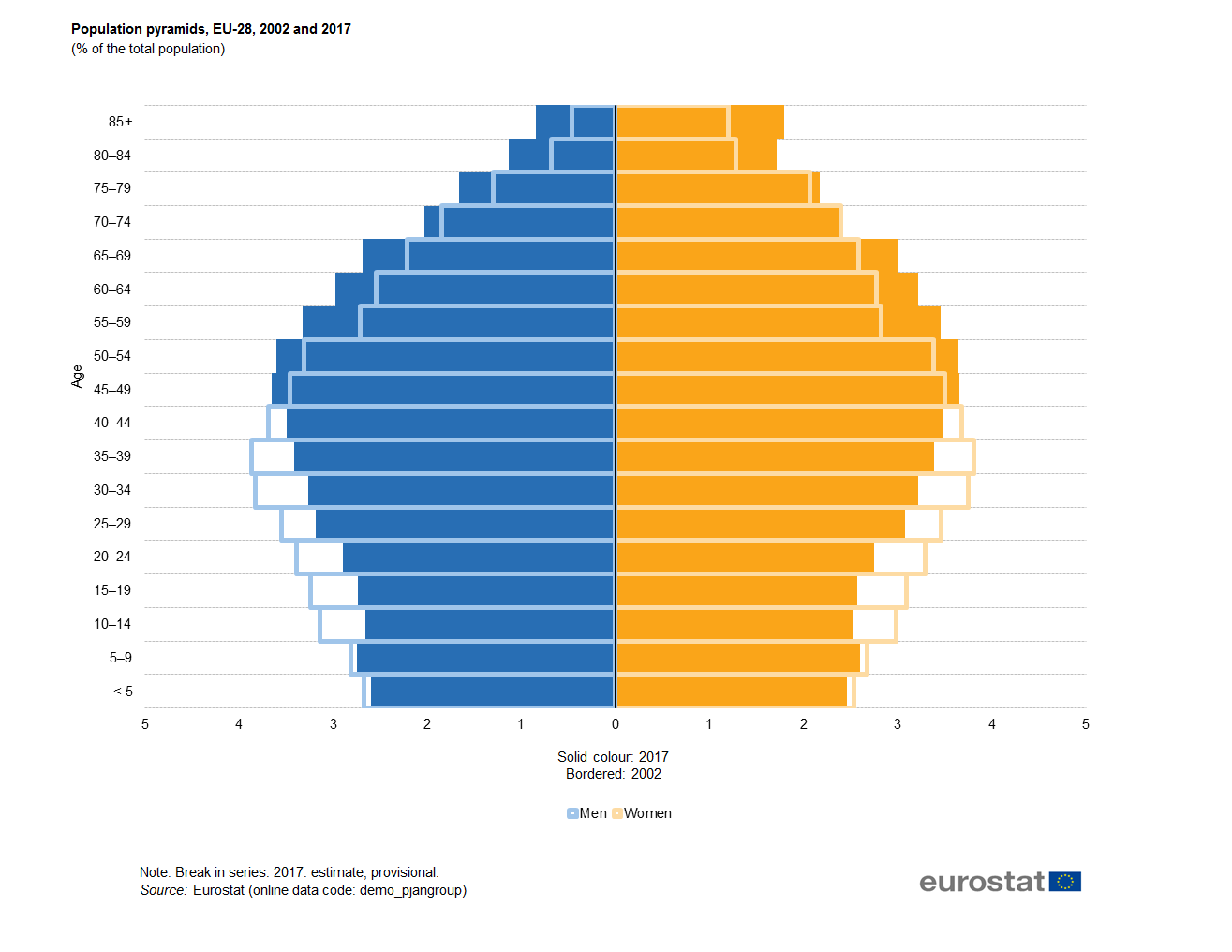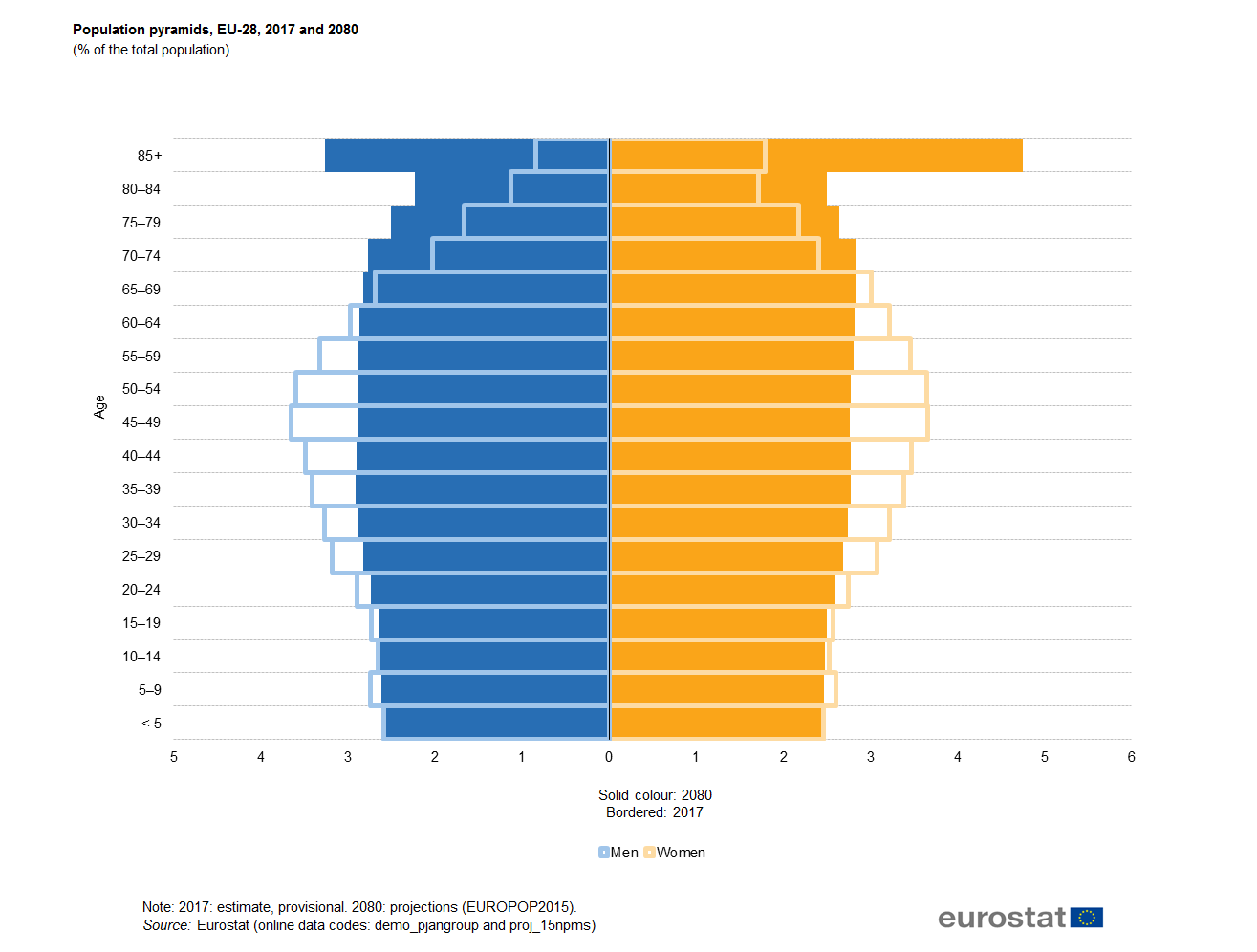What is the real demographic situation in Europe and what does it mean for ageing well?
The population ageing we see happening not just in the European Union (EU) but in the rest of the world is a long-term trend which began in the late 20th century. However, the impact of this shift that saw consistently low birth rates and higher life expectancy is reflected in a declining share of working-age persons, transforming the shape of the EU-28’s population pyramid.
This transition towards a much older population is already visible in several EU Member States. As a result, there are more people retiring and less people working. In the past two decades in fact, the share of the working-age population of the EU-27 increased by 0.3 per cent, while the share of the older population increased by 3.7 per cent.
Since then, on the 1 January 2017, it was estimated that the EU-28 population was 511.5million, of that young people made up 15.6 per cent whilst those of working age, up to 64 years old, accounted for nearly 65 per cent and of the total population the elderly had a share of 19.4 per cent. For more detailed data on where young people had the highest share, Ireland had 21 per cent, with Germany recording the lowest at 13.4 per cent. In comparison, the highest elderly population was in Italy (22.3 per cent) with Ireland having the lowest share (13.5 per cent).
If we look at the median age of the EU-28 population in January 2017, the development also provides a clear illustration of the ageing population; impressively, half of the population was older than 42.8 years. This has increased from 35.2 years in 1990 and 40.9 years in 2010. Albania actually experienced the biggest increase in the median age over the past 10 years, increasing from 28.9 years to 35.6 years.
Europe’s increasing dependency and AAL
With an increasing demographic, not only is the working age declining but the age dependency ratio of the older demographic is increasing. There is a real challenge developing where persons of working age are having to support their older relatives or friends. However, the size of the elderly population in comparison to those of working age does not match up. This disruption is meaning that in 2017 there were approximately two working age persons for every dependent person (inclusive of those younger than 15 who need looking after). France had the highest age dependency ratio at 60 per cent. In particular, in 2007 the old-age dependency ratio was 25.2 per cent and 10 years later it was almost 30 per cent.
This detrimental affect the changing demographic is having on the lives of those assisting the ageing population as friends, family or caregivers, is one the major challenges the AAL Programme is trying to address. If more ageing people are needing care then solutions and technologies need to be researched, innovated and created that enable people to live longer, healthier and independent lives. If you’re interested in seeing what products and solutions AAL have made into successful commercial businesses to help older individuals and their caregivers live easier lives, then check out the AAL Success Stories (link to success stories homepage).
EU’s Population Pyramid

A population pyramid is a clear and definitive way of seeing the distribution of the population by sex and age, grouped into five-year age brackets, in a given year. In the table above, the population pyramid shows the EU-28 age division in 2002 and again 2017. The solid colour represents 2017 and the borders represent 2002.
In both cases, men and women correlate in population size. However, what is notable is that overall in 2002 we can see that the borders are significantly wider at the bottom and narrow to the top of the table, and yet this this has switched by 2017, with it being narrower at the bottom. This bulge can be associated with the baby boom generation of the 1960s and the high fertility rates and which currently represents a major part of the working-age population. However, this larger generation is becoming an issue as the bulge is now beginning to reach retirement age leaving the bottom of the table, the younger generations, much smaller.
If we look to future statistics and what this means in 60 years, it is estimated by Eurostat’s latest set of population projections covering 2015 to 2080 that the population distribution will look something like this:

If this graph is representative of what will happen, then the share of those aged 80 years or above will have doubled from 5.5 per cent to 12.7 per cent and those aged 65 years and older will account for 29.1 per cent of the EU’s population and the old-age dependency will be a staggering 52.3 per cent.
AAL and the changing demographic
Growing up in a society that is governed by a majority of those in the older age groups is completely different to growing up in a society where the majority is of younger people. This fundamental change requires transformation and the AAL Programme is acting to respond to this demographic shift in a number of ways by changing: how we think about the age, how we interact between the ages, how we communicate with different healthy ageing markets, how we adapt our personal and communal environments and how we learn from one another. AAL encompasses of all this and focuses on how we can exploit the benefits of today’s technology to achieve it.
With the EU-28 statistics on our ageing society, the Active and Assisted Living Programme is continually researching what they really represent for society and how the programme will keep going forward in terms of policies, products, solutions and the expertise is uses to make a difference to not just our ageing lives in Europe, but as precedence for around the world. AAL’s commitment to the changing demographic will be the driving force behind successful adaption and adoption of healthier, active and independent living in our ageing society.
Take a look at the plethora of projects in the AAL community.
Ageing facts and figures
- The number of people aged from 65 to 80 will rise by nearly 40 per cent between 2010 and 2030
- The number of people aged 85 years and older will rise from 14 million to 19 million by 2020 and to 40 million by 2050
- The baby-boom generation are beginning to reach retirement age leaving behind far smaller younger and working-age generations
- Public spending excluding interest payments to increase by £79 billion of GDP due to the ageing population in the UK alone



